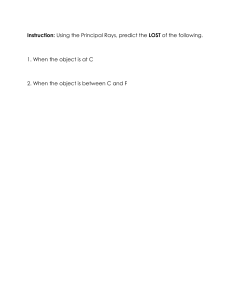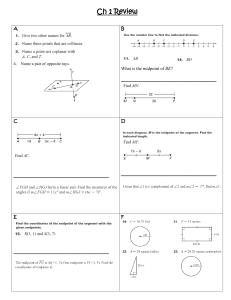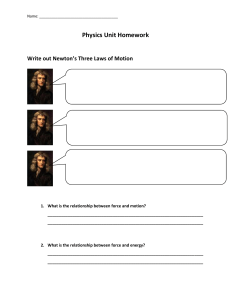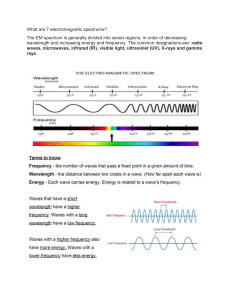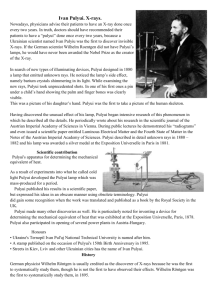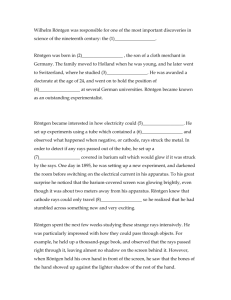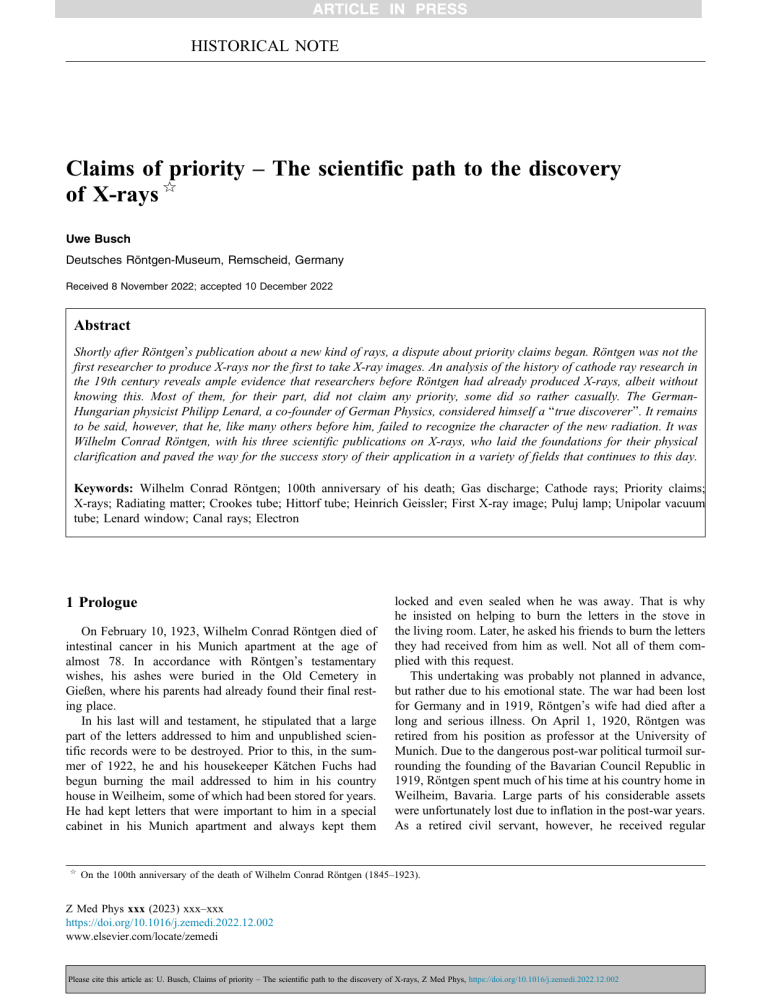
HISTORICAL NOTE Claims of priority – The scientific path to the discovery of X-rays q Uwe Busch Deutsches Röntgen-Museum, Remscheid, Germany Received 8 November 2022; accepted 10 December 2022 Abstract Shortly after Röntgen’s publication about a new kind of rays, a dispute about priority claims began. Röntgen was not the first researcher to produce X-rays nor the first to take X-ray images. An analysis of the history of cathode ray research in the 19th century reveals ample evidence that researchers before Röntgen had already produced X-rays, albeit without knowing this. Most of them, for their part, did not claim any priority, some did so rather casually. The GermanHungarian physicist Philipp Lenard, a co-founder of German Physics, considered himself a “true discoverer”. It remains to be said, however, that he, like many others before him, failed to recognize the character of the new radiation. It was Wilhelm Conrad Röntgen, with his three scientific publications on X-rays, who laid the foundations for their physical clarification and paved the way for the success story of their application in a variety of fields that continues to this day. Keywords: Wilhelm Conrad Röntgen; 100th anniversary of his death; Gas discharge; Cathode rays; Priority claims; X-rays; Radiating matter; Crookes tube; Hittorf tube; Heinrich Geissler; First X-ray image; Puluj lamp; Unipolar vacuum tube; Lenard window; Canal rays; Electron 1 Prologue On February 10, 1923, Wilhelm Conrad Röntgen died of intestinal cancer in his Munich apartment at the age of almost 78. In accordance with Röntgen’s testamentary wishes, his ashes were buried in the Old Cemetery in Gießen, where his parents had already found their final resting place. In his last will and testament, he stipulated that a large part of the letters addressed to him and unpublished scientific records were to be destroyed. Prior to this, in the summer of 1922, he and his housekeeper Kätchen Fuchs had begun burning the mail addressed to him in his country house in Weilheim, some of which had been stored for years. He had kept letters that were important to him in a special cabinet in his Munich apartment and always kept them q locked and even sealed when he was away. That is why he insisted on helping to burn the letters in the stove in the living room. Later, he asked his friends to burn the letters they had received from him as well. Not all of them complied with this request. This undertaking was probably not planned in advance, but rather due to his emotional state. The war had been lost for Germany and in 1919, Röntgen’s wife had died after a long and serious illness. On April 1, 1920, Röntgen was retired from his position as professor at the University of Munich. Due to the dangerous post-war political turmoil surrounding the founding of the Bavarian Council Republic in 1919, Röntgen spent much of his time at his country home in Weilheim, Bavaria. Large parts of his considerable assets were unfortunately lost due to inflation in the post-war years. As a retired civil servant, however, he received regular On the 100th anniversary of the death of Wilhelm Conrad Röntgen (1845–1923). Z Med Phys xxx (2023) xxx–xxx https://doi.org/10.1016/j.zemedi.2022.12.002 www.elsevier.com/locate/zemedi Please cite this article as: U. Busch, Claims of priority – The scientific path to the discovery of X-rays, Z Med Phys, https://doi.org/10.1016/j.zemedi.2022.12.002 2 U. Busch / Z Med Phys xxx (2023) xxx–xxx pension payments and therefore did not have to suffer any hardship. Nevertheless, all this may have influenced his decision. Another reason could be that Röntgen certainly also wanted to avoid his documents falling into the hands of colleagues and envious people who could use them against him. For early on, there were rumours that Röntgen was not the first discoverer of the rays at the Physics Institute of the University of Würzburg, but that his institute servant Marstaller was the chance discoverer. This is the subject of a discussion that continues to this day on social media about the priority claims of the “true discoverers” of X-rays. 2 The route to the discovery- Research on cathode rays in the 19th century The history and the claims about the discovery of X-rays are a history of research on gas discharges in the 19th century. Gas discharge tubes were a popular attraction in vaudeville shows and fairgrounds in the last decades of the 19th century because of their mysterious luminous phenomena. For the pleasure of viewing the luminous phenomena, special gas discharge tubes were built that contained various fluorescent crystals arranged in flower bouquets. In the second half of the nineteenth century, gas discharge became increasingly a subject of science. A new field of research emerged, which was steadily expanded by numerous innovative technical developments and skills. These technical innovations included, from the 1850s onwards, powerful high-voltage supplies, such as spark inductors, and especially the further development of the art of glass blowing. Here, the glassmakers from Thuringia in particular led the way. The town of Gehlberg became a center for the production of thermometers and technical glass articles for measuring instruments as late as the 19th century. The Gundelach company was also the first to build special X-ray tubes after the discovery became known. The development of modern mercury air-pumps made it possible to create the high gas dilution ratio in the tubes required for the experiments and the scientific analysis of the glow phenomena. However, low-pressure gas discharges are based on quite complex physical processes that cannot be easily explained. Therefore, gas discharges remained a rather exotic topic until the last decades of the 19th century. Nevertheless, before Röntgen started working on cathode rays, many scientists had already done research in that field. They all aimed to fathom the physical nature of the observable phenomena of luminosity. Until Röntgen’s research in 1895 and two years later, however, the nature of cathode rays remained unclear. This motivated Röntgen to conduct his own research. In the following, some of the important researchers and their contributions to the study of cathode rays in the context of possible priority claims for the discovery of X-rays are presented [1]. 2.1 Michael Faraday (1791–1867), Royal Institution London: First scientific research on glow discharges (1831–1838) Michael Faraday (Fig. 1) was an English scientist, inventor, assistant to Humphry Davy (1778–1829) and member of the Royal Society. He is considered one of the most important experimental physicists of the 19th century. In addition to his discoveries about electrolysis, electromagnetic induction, diamagnetism, and the invention of the terms ‘anode’ and ‘cathode’, he investigated electric current in evacuated glass tubes during the years 1831–1838. He had discovered that the sparks observed under atmospheric pressure change Figure 1. Michael Faraday by Thomas Phillips oil on canvas, 1841–1842 35 3/4 in. x 28 in. (908 mm x 711 mm) Purchased, 1868 NPG 269. (Michael Faraday – Wikipedia Wikimedia Commons). Please cite this article as: U. Busch, Claims of priority – The scientific path to the discovery of X-rays, Z Med Phys, https://doi.org/10.1016/j.zemedi.2022.12.002 U. Busch / Z Med Phys xxx (2023) xxx–xxx to a glow when the tube is conventionally evacuated to a pressure of about 10 mm mercury down to 0.01 mm mercury (13 mbar–0.013 mbar). At high DC voltages of 10,000 to 15,000 volts, he noticed glow discharges starting at the cathode and ending at the anode for various gases such as oxygen, hydrogen, and gas mixtures such as air (Fig. 2). When he lowered the gas pressure, typically to about 0.05 mm mercury, he noticed a dark spot between the negative glow and positive column, also known as the “Faraday dark space” [2]. 2.2 Francis Hauksbee (1660–1713), Royal Society London: Electrostatic Repulsion (1709) Despite his intensive research into gas discharges, Faraday, however, never mentioned anything about mysterious rays, that would indicate the existence of a radiation penetrating matter. Evidence for the existence of a penetrating type of radiation was mentioned by Francis Hausksbee in 1706. A British scientist, Fellow, and curator of experiments at the Royal Society in London, Francis Hauksbee was best known for his work on electricity and electrostatic repulsion. Using a modified electrifying machine, he succeeded in sucking out the air in a spherical container using mercury and electrostatically charging the sphere by rubbing it with 3 his hand (Fig. 3). This produced a rather bright light. This phenomenon is similar to St. Elmo’s fire and later became the basis for the development of glow lamps and mercury vapor lamps. In his treatise “Physico-Mechanical Experiments” (London 1709), he described a special phenomenon he recognized in an Experiment concerning the ’Produclion of Light in an exhausted Glass. “... My Hand was no sooner applied to that part of the Globe which was lined with the Sealing-Wax, but I saw the shape and figure of all the parts of my Hand (which touch’d the convex Surface of the Glass) distinctly and Perfectly upon the concave Superficies of the Wax within.” [3] 2.3 Julius Plücker (1801–1868) and Heinrich Geißler (1814–1879), University of Bonn – Discovery of elementspecific line spectra (1865) The beginning of a systematic exploration of lowpressure gas discharges is closely linked to the activities of the German mathematician und physicist Julius Plücker (Fig. 4) and the glassblower Heinrich Geißler at the Institute of Physics, University of Bonn. Plücker was fascinated by Faraday’s research, with whom he also kept up a lively correspondence, and he and his doctoral student Johann Wilhelm Hittorf experimented with gas discharge tubes. Figure 2. Schematic diagram and photograph of a direct current glow discharge showing the following structures: The cathode glow, i.e., the first violet glowing region immediately adjacent to the cathode; the cathode dark space (Hittorfscher Dunkelraum), i.e., the darker band between the two brighter regions adjacent to the cathode, where the electrons already have energy above the maximum of the excitation energy and can no longer excite the gas as efficiently; the negative glow, i.e., the second larger purplish glowing region next to the cathode, whose brightness gradually decreases toward the anode; the Faraday dark space, i.e., the region without glow near the center of the tube; the positive column, i.e., the pink glowing region filling the right side of the tube and representing a plasma with hot electrons. This region is characterized by low electric field strength and vanishing space charge and ensures current transfer between cathode and anode. In the photo, striation, i.e. alternating bright and dark bands, can be seen in the positive column, caused by an instability in the plasma; the anode glow, i.e. the bright layer on the far right in front of the anode (Gas discharge - Category:Gas discharge tube - Wikimedia Commons). Please cite this article as: U. Busch, Claims of priority – The scientific path to the discovery of X-rays, Z Med Phys, https://doi.org/10.1016/j.zemedi.2022.12.002 4 U. Busch / Z Med Phys xxx (2023) xxx–xxx Figure 3. Plate VII ’A continuation of the Experiments on Attrition of Glass’ and ’Some further Experiments relating to Electricity of Glass’ from Physico-Mechanical Experiments various subjects, presented to the Royal Society on October 1709 (Francis Hauksbee – Wikipedia Wikimedia Commons the the on 26, First alone and later with Hittorf, he first investigated the magnetic deflection of cathode rays. Together they made many further important discoveries. Both showed that any gas could be made to discharge when a certain voltage was applied, each with an element-specific line spectrum. In 1862, Plücker pointed out that the same element may exhibit different spectra at different temperatures. The success of the experiments carried out was due in no small part to the ingenious glassblower Heinrich Geißler (Fig. 5). In 1865, Plücker and Hittorf described their research results in a publication of the Royal Society in London. [4] The results were groundbreaking for future research on atoms and the development of spectral analysis. Figure 4. Julius Plücker (1801–1868). Lithographie von Rudolf Hoffmann, 1856. (Julius Plücker – Wikipedia Wikimedia Commons). 2.4 Johann Wilhelm Hittorf (1824–1914), University of Münster: Discovery of cathode rays (1869) For further investigations on discharge phenomena, Wilhelm Hittorf (Fig. 6) improved his apparatus. At the World Exhibition in Paris 1867, he acquired the spark inductor invented by the German-French mechanic and instrument maker Heinrich Daniel Rühmkorff (1803–1877). With this device, later referred to as the Rühmkorff inductor, Hittorf was able to generate a pulsating voltage of about 100,000 volts from a DC voltage of 15 volts. Hittorf also set about improving the vacuum and developed a special discharge tube called the Hittorf tube (Fig. 7). Shortly after Plücker’s death in 1869, Hittorf discovered and described the main properties of the rays originating from the cathode and extending to the anode. Hittorf found that cathode rays propagate in a straight line, produce fluorescence when they strike the glass wall, and that a metal foil in the path of Please cite this article as: U. Busch, Claims of priority – The scientific path to the discovery of X-rays, Z Med Phys, https://doi.org/10.1016/j.zemedi.2022.12.002 U. Busch / Z Med Phys xxx (2023) xxx–xxx 5 Figure 5. Heinrich Geissler (1814–1879). (Heinrich Geißler (Glasbläser) – Wikipedia Wikimedia Commons). the rays casts shadows. Taking into account Plücker’s results on magnetic deflection, he explained the motion of the cathode rays from the cathode as a simple negative current. First in 1869 [5] and then until 1884, Hittorf published four groundbreaking papers on the study of the passage of electricity through gases. In this way, he succeeded in exploring the main properties of cathode rays, which were so named by the German physicist Eugen Goldstein in 1876. Hittorf’s pioneering research was an important step on the way to the discovery of X-rays [6]. Figure 6. Johann Wilhelm Hittorf. Taken from the Festschrift on the occasion of Johann Wilhelm Hittorf’s 80th birthday. Leipzig: Barth 1904. Adolf Heydweiller, Münster (Johann Wilhelm Hittorf – Wikipedia Wikimedia Commons). 2.5 William Crookes (1832–1919), Royal Society London: Linear beams and Radiant Matter (1879) of tube emit blue light and the photographic plates show ’foggy’ shadows [...]” [7]. During his investigations on the conduction of electricity in low-pressure gases, the British chemist, physicist and parapsychologist William Crookes discovered that the negative electrode (cathode) emits rays as the pressure decreases. In his research with heavily evacuated glass tubes, Crookes was able to detect the cathode rays as a shadow-casting cross by using a special design of the anode (made of aluminium) (Fig. 8). When cathode rays strike glass or other materials, a fluorescent glow is produced. He pioneered the construction and use of vacuum tubes to study the physics of plasma in 1879. Crookes is believed to have observed radiating atoms or matter in a special state. He called this radiant type of matter a fourth state of matter. During his experiments he also noticed veils on photographic plates. “[...] the walls 2.6 Eugen Goldstein (1850–1930), Urania Berlin: Canal rays (1886) Building on the work of Plücker and Hittorf, Eugen Goldstein from Berlin conducted extensive pioneering gas discharge experiments, for which he had almost 2,000 tubes manufactured by 1885, some of which he paid for out of his own pocket. In 1876, he found that rays were emitted perpendicular to the cathode surface. Goldstein first called them “cathode rays” and understood them as a fundamental phenomenon of electricity, but interpreted them – in the tradition of Hermann Helmholtz – as ether phenomena. With William Crookes he had a scientific dispute about the corpuscular nature of cathode rays. Please cite this article as: U. Busch, Claims of priority – The scientific path to the discovery of X-rays, Z Med Phys, https://doi.org/10.1016/j.zemedi.2022.12.002 6 U. Busch / Z Med Phys xxx (2023) xxx–xxx Figure 8. Crookes shadow cross tube (Crookes tube two views File:Crookes tube two views.jpg - Wikimedia Commons). other physicists in their search for atomic beams and mass spectroscopy. Figure 7. Gas discharge tube of the Hittorf type. The first experiments with X-rays took place with tubes that were initially still cylindrical. The end of the glass bulb acted as an anti-cathode, but the radiation was still quite diffuse. (Archiv Deutsches Röntgen-Museum). In 1886 Goldstein discovered the anode rays, which are produced by positively charged ions after impact ionization in the cathode ray tubes (Fig. 9). These ions are accelerated towards the cathode, pass – if the cathode is provided with holes – through these holes (“channels”) due to their inertia and can be detected behind the cathode by their luminous phenomena. Goldstein therefore called them “canal rays” (German “Kanalstrahlen”). Since the canal rays went in the opposite direction as the “cathode rays”, Goldstein speculated that these rays consisted of positively charged particles. About 15 years later, the physicist Wilhelm Wien proved that these rays were positive ions from the gas. The nine-page 1886 Academy paper went unnoticed at the time, especially since the channel ray did not particularly stand out among the variety of gas discharge phenomena [8]. This changed with the discovery of the X-rays, when the channel rays also gained importance for a short time. However, Goldstein’s work had opened new avenues for 2.7 Johann Puluj (1845–1918), University of Prague: Puluj Lamp (1881) Johann Puluj was an Austrian-Hungarian physicist and electrical engineer of Ukrainian nationality. In 1876, he received his doctorate from the University of Strasbourg under Röntgen’s mentor August Kundt. Puluj’s scientific interests included the study of cathode radiation. He investigated and described their interaction with magnetic fields and showed similarities to electric currents in solids. He published his results in four articles between 1880 and 1882. Puluj, however, rejected the Crookes hypothesis of a fourth state of matter to explain the cathode rays. He described the idea as “transcendental” with an inclination towards spiritualism. Referring to the work of Hittorf, he proposed a more materialistic and mechanical explanation. According to his hypothesis, physical particles should be mechanically released from the electrodes. They are negatively charged and move in a straight line at high speed in the tube to the positive electrode. Together with the residual molecules of the gas, they mediate the electrical conduction of electricity between the electrodes in the discharge tube. In the course of his research, he developed luminescent lamps, which were later called Puluj lamps (Fig. 10). Puluj was the first to incorporate an additional electrode, the Please cite this article as: U. Busch, Claims of priority – The scientific path to the discovery of X-rays, Z Med Phys, https://doi.org/10.1016/j.zemedi.2022.12.002 U. Busch / Z Med Phys xxx (2023) xxx–xxx 7 Figure 10. Puluj lamp. Courtesy of Museum Experimentalphysik Innsbruck. scientists knew each other, Röntgen, like Lenard, never later cited Puluj’s research. 2.8 Arthur W Goodspeed (1860–1943), University of Pennsylvania: Unrecognised first radiograph (1890) Figure 9. Canal rays: Anode-ray tube showing the rays passing through the perforated cathode and causing the pink glow above it (Anode ray - Wikipedia Wikimedia Commons). so-called anticathode, into the tube in addition to the cathode and anode. He published the results of his research on “Radiant Electromatter” between 1880–1882 in the Vienna Reports and in 1883 in a monograph [9]. The phenomena he described were probably indeed X-rays, and his lamp was in principle a prototype of an X-ray tube. Puluj, however, resumed his research only after the publication of Röntgen’s first treatise on the new rays in January 1896. He published his first paper on X-rays already on February 13, 1896 [10]. Puluj was one of the first physicists to recognise the potential of X-rays for medical diagnostics and produced numerous X-ray images. With his research, Puluj certainly laid an important foundation for Röntgen’s discovery of X-rays. Therefore, some journalists called him the discoverer of X-rays [11,12]. Puluj himself acknowledged Röntgen’s priority. Although both On the evening of February 22, 1890, American physicist Arthur Goodspeed and photographer William N. Jennings (1860–1945) were experimenting with high-voltage discharges in the physics laboratory at the University of Pennsylvania. As early as the fall of 1889, they had begun comparing various forms of artificial electrical discharges generated by various devices with Jennings’ earlier photographs of natural lightning. That evening, they photographed lightning and tuft discharges generated by spark generators. They also placed coins and weights on unexposed photographic plates. After they finished their experiments, there were still some unexposed photographic plates in corresponding photographic cassettes on their experimental table. Goodspeed took some of Crookes discharge tubes from his collection, hooked them up, and showed Jennings the fascinating glow in the tubes. Enthusiastic and engrossed in conversation about cathode radiation, they forgot about the unexposed photo cassettes lying next to the tubes. A few days later, Jennings reported that while developing all the photographic plates, even those that were not directly exposed, he noticed something strange. Circular structures overlaid with spark marks appeared on one plate. The structures were completely different from those on the directly exposed photographic plates. Neither the photographer nor the physicist could explain this strange effect. Was it a manufacturing defect? Goodspeed put the negative aside along Please cite this article as: U. Busch, Claims of priority – The scientific path to the discovery of X-rays, Z Med Phys, https://doi.org/10.1016/j.zemedi.2022.12.002 8 U. Busch / Z Med Phys xxx (2023) xxx–xxx with other strange plates. As time passed, no one gave it a second thought. Six years later, Arthur Goodspeed also learned of the discovery of new, penetrating rays by the German physicist Roentgen in Würzburg. Goodspeed remembered the plate put aside and studied it again. The logical explanation could only be that he and Jennings had unknowingly taken the first X-ray picture of coins on February 22, 1890 (Fig. 11). Goodspeed then repeated his experiments under the same conditions, with the same apparatus and tubes, and he obtained comparable results. At the American Philosophical Society meeting on February 21, 1896, Goodspeed gave a remarkable experimental lecture on X-rays and told the story of this first “radiation accident” in history, almost exactly six years ago. At the end of his lecture, Goodspeed said: “Now, gentlemen, we wish it clearly understood that we claim no credit whatever for what seems to have been a most interesting accident, yet the evidence seems quite convincing that the first Röntgen shadow picture was really produced almost exactly six years ago to night, in the physical lecture room of the University of Pennsylvania” [13]. In a letter to the German-American medical physicist and Röntgen biographer Otto Glasser (1895–1964) dated February 15, 1929, Goodspeed regretted not having investigated the findings: “[...] The accidental roentgen effect which W. N. Jennings and I produced in 1890 was real and authentic. Because of our laxity in not following the matter up we do not claim any credit whatsoever [...]” [14]. 2.9 Nikola Tesla (1856–1943), New York: Phosphorescent lamps and an unidentified radiograph (1894) Tesla on the internet, who repeatedly post the claim that Tesla is the true discoverer of X-rays. As early as 1891, Tesla experimented with high-frequency gas discharges. He then developed a unipolar gas discharge tube and in January 1894 he undertook experiments on photography with phosphorescent lamps. On a photograph of the American writer, humorist, entrepreneur, publisher, and lecturer Marc Twain, an adjusting screw inside his camera lens is said to have been visible on the picture [15]. Whether Tesla did further early research on this phenomenon cannot be proven, as unfortunately much of his work was lost when his laboratory in New York burned down on March 13, 1895. Tesla, however, did not begin to work intensively on X-rays until after Röntgen’s announcement (Fig. 12). He published numerous papers on X-rays in the course of 1896, including their biological effects. The New York Herald reported on February 23, 1896, that Tesla had also succeeded in taking the first Xray image of the human brain. From today’s perspective, however, this was a false report. Tesla took early radiographs and sent a collection to Röntgen, who thanked Tesla and congratulated him on the excellent images. 2.10 Philipp Eduard Anton Lenard (1862–1947), University of Bonn: Passing of cathode rays through thin foils (1894) I am the mother of X-rays. Just as the mid-wife is not responsible for the mechanism of birth, so was Roentgen not responsible for the discovery of X-rays since all the groundwork had been prepared by me. Without me, the name of Roentgen would be unknown today. [16] There are a large number of followers of the SerbianAmerican inventor, physicist and electrical engineer Nikola Figure 11. X-ray image of two American coins. (Archiv Deutsches Röntgen-Museum). Figure 12. Telegram from Tesla to Röntgen dated March 14, 1896 (Archive Deutsches Röntgen-Museum). Please cite this article as: U. Busch, Claims of priority – The scientific path to the discovery of X-rays, Z Med Phys, https://doi.org/10.1016/j.zemedi.2022.12.002 U. Busch / Z Med Phys xxx (2023) xxx–xxx After his habilitation on water electricity with Heinrich Hertz (1857–1894) in Bonn, Philipp Lenard worked on other electrical phenomena, such as thunderstorm electricity. His special interest, however, was in the study of the passage of cathode rays through thin layers of material. As early as 1892, Hertz had discovered that a thin metal sheet transmitted cathode rays. Hertz used quite thin, very soft and porous gold, silver and aluminium bookbinding sheets, but showed that the cathode rays passed not only through the holes but also through the material itself, i.e., the metal of the sheets. This prompted Lenard to insert a thin, vacuum-tight aluminum window in the wall of a tube through which the cathode rays could pass from the vacuum of the tube into the air. In addition to the different penetrating powers, Lenard was later able to demonstrate the photographic effect and the magnetic deflection of cathode rays. In 1894, he published his results in the Annalen der Physik [17]. His research and the use of the “Lenard window” provided the first opportunity to study cathode rays outside the discharge tube (Fig. 13). Lenard’s results contributed to further research into the physical nature of cathode rays. Using his research results, the British physicist Joseph John Thomson (1856–1940) later in 1897 succeeded in proving that cathode rays are made of electrons. This embittered Lenard greatly. But he was even more embittered by the discovery of X-rays in November 1895, since Röntgen had received the essential information for the cathode ray experiments as well as a discharge tube directly from Lenard. After Röntgen became famous for the discovery of X-rays, Lenard accused him of having robbed him of the discovery [18]. The dispute was further fuelled by the award of the first Nobel Prize to Wilhelm C. Röntgen, especially since the Nobel Committee had initially thought of awarding Lenard and Röntgen the first Nobel Prize in 1901. Lenard later received the Nobel Prize in Physics in 1905 “for his work on cathode rays”. The conflict, which had been simmering for decades, flared up again during the National Socialist era in Germany in the late 1930s. Because of his early membership in the Nazi Party (NSDAP), Lenard, with the help of the National Socialist press and some party members, succeeded in stirring up considerable controversy over Röntgen’s position in science. During this period, Lenard, not Röntgen, was credited with the discovery of X-rays by the Third Reich. Lenard also emphasized this in the preface to his four-volume work on German physics published in 1936. Instead of “X-rays” he used the term “highfrequency rays” [19]. 2.11 Wilhelm Hallwachs (1859–1922), Technical University Dresden: The missed chance (1895) Another excellent experimental physicist also narrowly missed the discovery of X-rays. Wilhelm Hallwachs 9 Figure 13. Lenard discharge tube (Archive Deutsches RöntgenMuseum). (Fig. 14), who had studied under August Kundt in Strasbourg and Friedrich Kohlrausch (1840–1910) in Würzburg, was, like Röntgen, a master of experimental physics who designed and built many devices himself. In 1893, he became a full professor of electrical engineering at the Technical University of Dresden. There he succeeded August Toepler (1836–1912) as full professor of physics in 1900. His greatest scientific achievement was the fundamental study of the external photoelectric effect discovered by Heinrich Hertz in 1887, i.e., the escape of electrons from surfaces when irradiated with suitable light. For this reason, the photoelectric effect was also called the “Hallwachs effect” for a short time. In any case, the effect opened the door to quantum mechanics [20]. Albert Einstein (1879–1955) later realized that this photoelectric effect can only be explained if one assumes that the light hits the metal in individual portions – as “light particles”, or “photons”. The energy of each photon is thereby determined by its wavelength. In the estate of senior engineer Horst Beger, former chief designer at the Koch & Sterzel X-ray company in Dresden, the son-in-law of Wilhelm Hallwachs reports on his father-in-law’s early experiments with cathode rays and his regret about the course of fate. “My father-in-law Hallwachs Please cite this article as: U. Busch, Claims of priority – The scientific path to the discovery of X-rays, Z Med Phys, https://doi.org/10.1016/j.zemedi.2022.12.002 10 U. Busch / Z Med Phys xxx (2023) xxx–xxx Figure 14. Wilhelm Hallwachs (1859–1922) (Wikimedia commons. Wilhelm Hallwachs | Niels Bohr Library & Archives (aip. org)). had worked in the same field (X-rays) and found satisfaction in experimentation, but he had not been able to achieve success. At that time, Gundelach [21] (Fig. 15) had built five tubes and delivered them to five universities; the matter was on the trail in the small circle of physicists. The tube for Hallwachs arrived defective - until it was returned repaired, by which time Röntgen had published. My father-in-law once told me, rather sadly, that immortality had thus passed him by” [22]. 2.12 Wilhelm Conrad Röntgen (1845–1923): University of Würzburg: Scientific research on X-rays (1895) Probably in the spring of 1894, Röntgen became aware of Lenard’s work on cathode rays. Röntgen later never divulged what measurements he intended to make. In an interview with the American reporter H. J. Dam from McClure’s magazine, he said: “I have been for a long time interested in the problem of the cathode rays from a vacuum tube as studied by Hertz and Lenard. I had followed theirs and other researches with great interest, and determined, as soon as I Figure 15. Advertisement for X-ray tubes by the Gundelach company from May 1896 (Courtesy of Glasmuseum Gehlberg). had the time, to make some researches of my own. This time I found at the close of last October (1895). I had been at work for some days when I discovered something new“ [23]. On Friday, November 8, 1895 late in the afternoon Röntgen set up some experiments on cathode rays in his laboratory at the University of Würzburg (Fig. 16). He used a simple ionising Crookes type or Hittorf tube, an induction coil, and a modern vacuum pump. “A discharge from a large induction coil is passed through a Hittorf’s vacuum tube, or through a well-exhausted Crookes’ or Lenard’s tube. The tube is surrounded by a fairly close-fitting shield of black paper; it is then possible to see, in a completely darkened room, that paper covered on one side with barium platinocyanide lights up with brilliant fluorescence when brought into the neighborhood of the tube. Whether the painted side or the other be turned towards the tube. The fluorescence is Please cite this article as: U. Busch, Claims of priority – The scientific path to the discovery of X-rays, Z Med Phys, https://doi.org/10.1016/j.zemedi.2022.12.002 U. Busch / Z Med Phys xxx (2023) xxx–xxx 11 which caused a deflection of the cathode rays in the Crookes tube. In 1897, he repeated the experiment with different anode materials and different gases, but the deflection remained the same. To determine the massto-charge-ratio of these particles, he equated the magnetic deflection with the electric one. After the Irish physicist Johnstone Stoney (1826–1911) had already proposed in 1878 the existence of an electric charge carrier of uniformly large charge associated with atoms and coined as “electron”, Thomson succeeded in providing the first experimental proof of the electron on April 30; 1897. “As the cathode rays carry a charge of negative electricity, are deflected by an electrostatic force as if they were negatively electrified, and are acted on by a magnetic force in just the way in which this force would act on a negatively electrified body moving along the path of these rays, I can see no escape from the conclusion that they are charges of negative electricity carried by particles of matter” [25]. He found that each of the particles had the same small mass, about 1/2000 of the mass of a hydrogen atom. In this way he had discovered the electron as a negatively charged elementary particle. It should not remain unmentioned here that in the late 1920s J. J. Thomson’s son George Paget Thomson Figure 16. Röntgen’s glass plate for investigating permeability with increasing layer thickness (Archiv Deutsches RöntgenMuseum). still visible at two meters distance. lt is easy to show that the origin of the fluorescence lies within the vacuum tube” [24]. 3 Epilogue 3.1 Joseph J. Thomson (1856–1940), Cavendish Laboratory Cambridge University: 1/2000 of the hydrogen atom (1897) The clarification of the physical nature of cathode radiation finally took place at the Cavendish Laboratory in Cambridge, UK. Sir Joseph John Thomson (Fig. 17), British physicist, president of the Royal Society, teacher of Ernest Rutherford and winner of the Nobel Prize in physics in the year 1906, succeeded in deciphering the nature of the cathode rays by conducting different experiments. Thomson was the first to recognize that all the cathode rays have the same origin and that cathode rays were charged particles or, as he called them, “corpuscles”. To prove this, he used magnets, Figure 17. Joseph J Thomson (1856–1940) steel engraving from 1896. Taken from The Electrician, 1896 - The Electrician, 1896, p.120 ISBN 0-87942-238-6, (File:JJ Thomson.jpg - Wikimedia Commons) Wikimedia Commons. Please cite this article as: U. Busch, Claims of priority – The scientific path to the discovery of X-rays, Z Med Phys, https://doi.org/10.1016/j.zemedi.2022.12.002 12 U. Busch / Z Med Phys xxx (2023) xxx–xxx (1892–1975) demonstrated that an electron can be diffracted like a wave. For the discovery of the wave-like properties of the electron, made at the University of Aberdeen, George P Thomson received the Nobel Prize in Physics in 1937, together with the American physicist Clinton Davisson (1881–1958), who had made the same discovery independently in 1927 at the Bell Telephone Laboratories. 4 Conclusion Despite numerous observations on the existence of a radiation penetrating matter in the 19th century, no questions or not the right questions were asked from the scientists to explain the observed phenomena. The phenomena remained unrecognised and uninterpreted until Wilhelm Conrad Röntgen tried to really question the observations. It is true that Röntgen was not the first to generate and observe X-rays but it was him who got to the bottom of the observations in his experiments and sought and found a scientific explanation for the new phenomena of invisible rays. Röntgen was the first to clearly identify the new phenomenon and to describe its properties precisely in the course of his meticulous research. He was thus also the first of the scientists to deliberately generate X-rays and make radiographs in order to make the invisible visible (Fig. 18). Röntgen was therefore awarded the first Nobel Prize in Physics “in recognition of the extraordinary services he has rendered by the discovery of the remarkable rays subsequently named after him”. Interestingly, among the 12 candidates nominated for the first Nobel Prize in Physics, the committee of the Royal Swedish Academy of Sciences had initially given preference to two proposals. Wilhelm Conrad Röntgen had the most advocates of all on his side. Philipp Lenard was nominated only by Silvanus P. Thompson (1851–1916), the London authority on cathode rays and X-rays. Nevertheless, the five-member committee, chaired by the Swedish astronomer and physicist Klas Bernhard Hasselberg (1848–1922), proposed that the prize be awarded equally to Röntgen and Lenard. In justifying its decision, the Nobel Committee speculated whether Lenard might not have discovered X-rays before Röntgen. In the committee’s view, however, this was not evident in Lenard’s work. This discussion contained the explosive material that was long debated. In the end, at its plenary session on November 12, 1901, the entire Academy in Stockholm finally overrode the recommendation of the prize committee and decided to award Röntgen an undivided prize, emphasizing the achievements of Lenard and other scientists mentioned in this article in the study of cathode rays and stressing that “Röntgen’s work on cathode rays led him, however, to the discovery of a new and different kind of rays” [26]. In his presentation speech, Swedish historian and president of the Royal Swedish Academy of Sciences, Clas Theodor Odhner (1836–1904), emphasised in particular the great significance of Röntgen’s discovery for medical practice. The important question of the physical nature of X-rays, which Röntgen was unable to answer, later similarly gave rise to two bearings in the discussion on clarifying the nature of light: those who saw in X-rays as having a wave character like Charles Glover Barkla (1877–1944) and those who advocated a corpuscular theory like William Henry Bragg (1862–1942). Declaration of Competing Interest The authors declare that they have no known competing financial interests or personal relationships that could have appeared to influence the work reported in this paper. Acknowledgements Figure 18. Wilhelm Conrad Röntgen in his physics institute in Würzburg portraits by Nicola Perscheid (1864–1930) for the making of the Röntgen Monument by Reinhold Felderhoff (1865– 1919), which was erected on the Potsdamer Bridge in Berlin in 1898. (Archiv Deutsches Röntgen-Museum). I would like to thank Prof. Dr. Jürgen Reichenbach, University Hospital Jena for his numerous valuable suggestions and proposals as well as Dr. Arpan K. Banerjee, Retired consultant radiologist, Chairman International Society for the History of Radiology (ISHRAD), Birmingham, UK, for reviewing the manuscript. Please cite this article as: U. Busch, Claims of priority – The scientific path to the discovery of X-rays, Z Med Phys, https://doi.org/10.1016/j.zemedi.2022.12.002 U. Busch / Z Med Phys xxx (2023) xxx–xxx References [1] Parts of the article are taken from the book: Busch U (Ed.). Wilhelm Conrad Röntgen – A shining life for science. Classic texts in science. Birkhäuser; 2021. p. 94–6. [2] More H. Cathode rays; 2020. https://thefactfactor.com/tag/faradaysdark-space/. Site visited 20.10.2022. [3] Hauksbee F. Physico-mechanical experiments on various subjects, containing an account of several surprizing phaenomena touching light and electricity. Producible on the attrition of bodies. With many other remarkable appearances, not before observ’d. Together with the explanations of all the machines, (the figures of which are curiously engrav’d on copper) and other apparatus us’d in making the experiments. London, Printed by R. Brugis, for the author; 1709. p. 133–97. https://archive.org/search.php?query=Hauksbee% 20Physico-Mechanical [4] Hittorf JW, Plücker J. On the spectra of ignited gases and vapours with especial regard to the same elementary gaseous substance. Philos Trans R Soc (Lond) 1865;155:1. [5] Hittorf JW. Ueber die Elektricitätsleitung der Gase. Ann Phys Chem 1869;212:1–31, 197–234. [6] For further readings: Müller F. Johann Wilhelm Hittorf and the material culture of nineteenth-century gas discharge research. Brit J History Sci 2011;44(2):211–244. https://doi.org/10.1017/S0007087 410001329. [7] Crookes W. On radiant matter a lecture delivered to the British Association for the Advancement of Science, at Sheffield, Friday, August 22, 1879; 1879. [8] Goldstein E. Vorläufige Mittheilungen über elektrische Entladungen in verdünnten Gasen (Preliminary communications on electric discharges in rarefied gases). Monatsberichte der Königlich Preussischen Akademie der Wissenschaften zu Berlin (Monthly Reports of the Royal Prussian Academy of Science in Berlin) 1876:279-–295. [9] Puluj J. Strahlende Elektrodenmaterie und der sogenannte vierte Aggregatzustand. Wien: Carl Gerold Sohn; 1883. [10] Puluj J. Über die Entstehung der Röntgenstrahlen und ihre photographische Wirkung. Wiener Berichte II Abt 1896;105: 228–238. [11] Hualla R. „Pulujisieren“ statt „Röntgenisieren“. Wochenendbeilage der oberösterreichischen Nachrichten; 3. Feb 1962. p. 13. 13 [12] Kulynyak D. Ivan Pului, the discoverer of X-rays. The Ukrainian Weekly. Parsippany, NJ: Ukrainian National Association, Inc.; 2000. p. 6. [13] Goodspeed AW. Remarks made at the Demonstration of the Röntgen Ray, at Stated Meeting, February 21, 1896. Proc Am Philos Soc 1896;35(150):17–36. [14] Glasser O. Arthur Willis Goodspeed. Science 1943;98(2540):219. [15] Hrabak M, Padovan R, Kralik M, Ozretic D, Potocki K. Scenes from the past. Nikola Tesla and the discovery of X-rays. Radiographics 2008;28:1189–1192. https://doi.org/10.1148/rg284075206. [16] Etter LE. Some historical data relating to the discovery of the Roentgen rays. Am J Roentgenol Radium Therapy Nucl Med 1946;56:220–231. [17] Lenard P. Ueber Katodenstrahlen in Gasen von atmosphärischem Druck und im äussersten Vacuum. Ann Phys Chem 1894;51 (2):225–267. [18] Peters C, Weckbecker A. On the way to power. On the history of the Nazi movement in Heidelberg 1920-1934 (published in German: Auf dem Weg zur Macht. Zur Geschichte der NS-Bewegung in Heidelberg 1920-1934. Dokumente und Analysen). Zeitsprung 1983;61. [19] Lenard P. German Physics, 4 vols. J.F. Lehmann-Verlag Munich; 1936. [20] Hallwachs W. Über den Einfluß des Lichtes auf electrostatisch geladene Körper. Ann Phys 1888;33:301–312. [21] At this time, the glassblower Emil Gundelach from Gehlbach was already producing Geißler tubes, fluorescence tubes, vacuum tubes, Puluj tubes, double radiometers, Tesla and Goldstein tubes. After the discovery of X-rays in 1895, ion X-ray tubes were also produced in Gehlberg. [22] Letter from Huch-Hallwachs to Horst Beger, Weilheim, 29.01.1969. Provided by Dr Bernd Seidel, who is processing the estate of Horst Beger. [23] Dam HJW. The New Marvel in Photography. McClure’s Magazine 1896;VI(5):401–415. [24] Roentgen WC. On a new kind of rays. Nature 1896;53:274–276, §1. [25] Thomson JJ. Cathode rays. Philos Mag 1897;44:293–316. [26] Wilhelm Conrad Röntgen Biographical. From Nobel Lectures, Physics 1901–1921, Elsevier Publishing Company, Amsterdam; 1967. https://www.nobelprize.org/prizes/physics/1901/rontgen/ biographical/ Available online at: www.sciencedirect.com ScienceDirect Please cite this article as: U. Busch, Claims of priority – The scientific path to the discovery of X-rays, Z Med Phys, https://doi.org/10.1016/j.zemedi.2022.12.002
